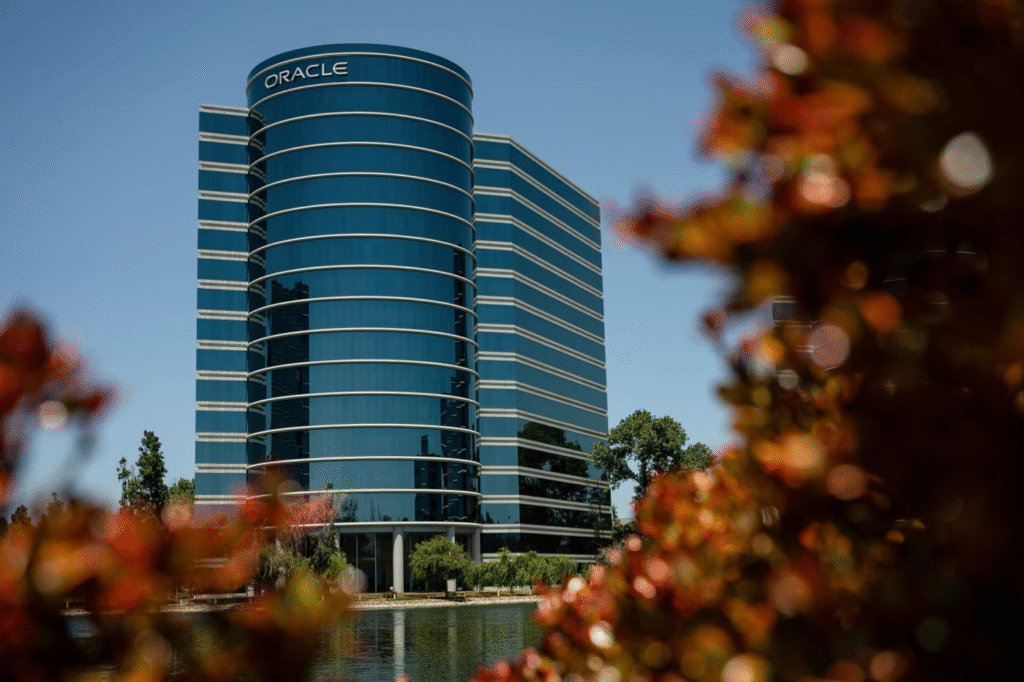📈 1. Company Overview
Oracle Corporation is a global leader in enterprise software, cloud infrastructure, and database management solutions. Founded in 1977 by Larry Ellison, Bob Miner, and Ed Oates, it revolutionized the relational database market. Headquarters currently in Austin, Texas (recently relocating HQ from Nashville), Oracle serves enterprises with integrated cloud, autonomous database, and AI services. It competes with tech giants like Amazon Web Services, Microsoft Azure, and SAP. The company has a diversified revenue mix across software, cloud, hardware, and consulting, with strong margins and cash flow.

2. 🗓️ Most Recent Earnings (Fiscal Q4 FY25 ended May 31, 2025)
On June 11, 2025, Oracle reported Q4 revenue of $15.9 billion (up 11% YoY), surpassing analyst forecasts of ~$15.6 billion. GAAP EPS came in at $1.19, while non‑GAAP (adjusted) EPS reached $1.70, beating estimates of $1.64. Cloud services and license support grew 14%, led by standout infrastructure growth—AWS-like OCI grew ~52% YoY to $3 billion. Management guided Q1 FY26 EPS between $1.46–1.50 on $14.9–15.2 billion revenue, in line with consensus; annual FY26 revenue is projected at $67 billion (≈+16–17%) .
3. 📜 Founding, Products & Funding
Oracle began in 1977 with relational database software and quickly became a database pioneer. Founders include Larry Ellison, Bob Miner, and Ed Oates . Over the decades, Oracle expanded via M&A, acquiring PeopleSoft, Sun Microsystems, NetSuite, and Cerner, pivoting toward cloud and SaaS. Offering on-premise and cloud databases, SaaS apps (e.g., ERP, HCM), OCI cloud IaaS/PaaS, and consulting, it competes with AWS, Azure, Google Cloud, SAP, and IBM. It operates globally, with R&D and data centers in Austin, Redwood City, Riyadh, Madrid, and more .
4. 🌐 Market & Growth Outlook
Oracle operates in cloud infrastructure, SaaS, and enterprise software markets projected to grow robustly. IDC and Gartner forecasts suggest cloud infra & platform growth at ~15–20% CAGR to 2030, while enterprise SaaS may expand ~12–15% CAGR. Oracle expects total cloud growth >40% in FY26, driven by infrastructure (70%) and remaining performance obligations (RPO) doubling, indicating strong backlog and recurring revenue. Its AI-integrated Oracle Cloud stacks up well in the enterprise digital transformation wave.
5. 💼 Competitor Landscape
Oracle faces stiff competition from AWS, Microsoft Azure, and Google Cloud in infrastructure. In databases and SaaS, it competes with SAP, Salesforce, Workday, and emerging AI-first vendors. Against hyperscalers, Oracle’s differentiation lies in enterprise-focused integration of its own applications and autonomous databases, though scalability and global reach remain areas of improvement. Its multi-cloud support—allowing Oracle databases on AWS/Azure—also distinguishes it .
6. 🚀 Unique Differentiation
Oracle’s differentiation lies in the tight integration of SaaS, PaaS, and its autonomous database technologies. Its strategy embeds generative AI capabilities at no extra cost within OCI and apps, backed by strong RPO backlog and Oracle Cloud@Customer offerings. Its multi-node GPU partnerships (e.g., Seekr/AMD Instinct) showcase competitiveness in AI training workloads. Its autonomous database and AI-powered enterprise stack offer smoother operations than competing separate services.
7. 👥 Management Team
- Safra Catz, CEO since 2014: Former CFO, spearheading transition to cloud and AI; recently guided FY26 revenue growth to 16–17% .
- Larry Ellison, CTO and Chairman: Driven enterprise cloud infrastructure expansion; notable build-out of data centers and aim to outbuild all competitors combined.
- Chris Gandolfo, EVP OCI & AI: Leads cloud infrastructure development and AI integration; featured in OCI AI deals like Seekr.
8. 💰 Financial Performance (Last 5 Years)
Oracle posted FY25 revenue of $57.4 billion (CAGR ~4–5% over past five years); FY24–FY25 growth ~8–9% . Non-GAAP EPS grew from ~$5.5 in FY20 to ~$6.0 in FY25—a slower CAGR (~2–3%), influenced by heavy cloud capex. Operating cash flow rose to ~$20.8 billion (+12% YoY FY25) . Balance sheet shows GAAP net income $12.4 billion FY25; non-GAAP $17.3 billion; strong margins but elevated debt-to-equity (~5.6). OCI expansion requires capex (~$25 billion planned FY26) but RPO backlog and high-margin cloud revenue suggest profitable scaling
9. 📊 Bull Case
- Cloud & AI growth acceleration: Q4 cloud +27%, IaaS +52%, guidance for +70% in infrastructure.
- Strong RPO/backlog (~$138 billion, up 41%), indicating future revenue visibility.
- Strategic differentiation via integrated SaaS + autonomous database + AI + OCI delivers enterprise value cost‑effectively.
10. 🐻 Bear Case
- High debt leveraged to finance capex (~debt-to-equity ~5.6); interest rate pressure risk.
- Intense competition from AWS, Azure, GCP on scale & price; Oracle is playing catch-up.
- Valuation premium (forward P/E ~26–43) may compress if growth slows or macro headwinds appear

The stock is in a stage 2 markup (bullish) on the monthly and weekly charts. The daily chart shows a strong move higher to the $200 zone. The earnings have been as strong catalyst to the higher move and should get to $200 with some resistance soon.
